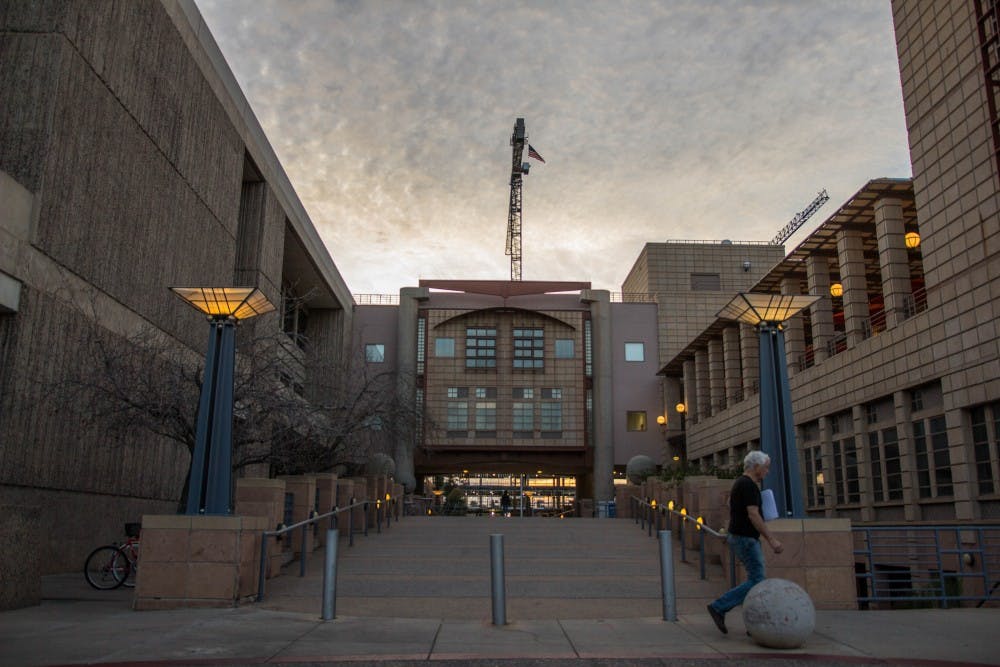Darrell Grissum described himself as a high-achieving student who found it difficult to communicate with anyone that he was struggling.
A sophomore at the time, Grissum worked for the ASU Residence Hall Association and had early access to the Design North lockers. He put his supplies in the locker two weeks before the start of the fall 2016 semester in preparation for the arduous weeks to come.
Without notice, University staff cut the locks and threw away the contents of Grissum’s locker contents one week before classes began, as they routinely do before each semester.
Grissum said he did not have the opportunity to process the fact that over $300 of his supplies required for the architecture program had been thrown away.
He was a financially self-supporting student, “If you don’t have (the money) you can’t get it.”
So Grissum told himself to suck it up. And that’s what he did. To make up for the loss, he borrowed from friends, dug through the trash and made his architectural models out of scraps.
This instance of what he called “pure unadulterated classism” was just one in a discouraging series of many that led him to change his major from architecture to interdisciplinary studies.
Students at the Design School at the Herberger Institute of Design and Arts pay steeply to afford the school’s required materials. Fourteen students who spoke to State Press Magazine reported costs between $160 and $1,000 each semester for supplies and printing.
They are forced to make frequent trips to the art supplies store and pay out-of-pocket for financially and environmentally unsustainable quantities of materials like paper, glue, chipboard, blades, exacto knives, pencils, tape, paint and wood throughout the year. If students do not use the correct supplies on projects, instructors can, and according to sources do, lower their grades.
Moreover, printing for some projects at the Design School can cost between $60 and $100.
Grissum said he was shocked to receive a C in a studio art class for not using the required type of paper, which he could not afford. Until then, he had never received a C in a class.
"(It was) not because I didn’t work hard enough or I wasn’t committed enough or I didn’t have a good idea or I didn’t have good stuff to present,” he said. “It was just because I didn’t have the resources that other people had.”
The Design School’s curriculum demands its students spend long hours in the art studios on campus, and balancing a job is a grueling cycle of exhaustion. When Grissum expressed this concern to an instructor, he was told he needed to “reevaluate his priorities.”
“What are you talking about?” Grissum recalled saying at the time, “That makes absolutely no sense because I absolutely cannot attend class if I do not work, so how is this a question of my priorities?”
The dread of spending aches throughout the Design School community.
Ben Lyons, a senior architecture student, said that the school’s staff has no respect or understanding for different financial situations.
“It’s very locked in the past and locked in this narrative of everyone is rich and nobody works,” he said.
Lyons said it would not be uncommon on a Monday for an instructor to tell students to have a $50 protractor and $40 vellum paper by Wednesday, or else their grades would be lowered.
The practices of the Design School, Lyons said, are outdated and much more wasteful than other prestigious design schools that use projection mapping and screens for presentations instead of paper.
“Does it always have to be printed?” he said, “It really doesn’t. But they make you print it all the time.”
Lyons listed multiple cheaper, more sustainable tactics the school could use to ease the strain on students, like buying materials in bulk at wholesale value, charging students at the beginning of the semester instead of throughout, or destigmatizing the use of technology.
“If they wanted to help people, they could,” he said.
The only form of compensation the school gives its students, he said, is when students are bought pizza during finals week.
“We don’t want pizza, we want free printing.”
Lyons said that due to the administration’s lack of support for low-income architecture students, he does not see himself working as an architect in the future.
Joe Davis, a graphic design freshman, said the cost can feel isolating to people who genuinely can’t pay for it.
“It just feels like a secret society that you have to pay your way into a little bit,” Davis said.
Davis pays for most of his printing and supplies himself.
“I would love to be able to not have to worry about going out to get a coffee,” he said. “That’s the kind of pressure it puts on me.”
Students are confused about why they are required to spend inordinate amounts of money on products when cheaper alternatives are available. At the beginning of some semesters, students must purchase pre-configured kits of brand-name supplies that run between $300 and $400.
“We definitely didn’t need all of that,” Chelsey Boyle, a graphic design freshman, said in reference to the set of materials.
While the aspiring designers yearn for more affordable alternatives, the idea of learning design principles theoretically through lectures leads them to question whether or not the supplies are necessary to begin with.
Maddy Anderson, a graphic design freshman, said, “We could also have a mini lecture and learn about (color theory) instead of spending $20 and figuring it out by experience.”
She spoke in reference to a project for graphic design freshmen where students have to learn how color interacts by repeatedly printing out different color variations. This project, she said, is what made her realize the tremendous amount of spending that was to come, not to mention the environmental cost of using so much paper.
Because color appears differently on paper than it does on screens, they couldn’t see if their work was correct until after they printed the pages. Anderson said instructors expected them to use high-quality paper that costs three dollars per sheet.
Matt Ransom, an academic advisor at Herberger, acknowledged that the required spending and printing for students puts a strain on students and the environment.
“Most faculty members are aware that students … have limited budgets and limited funds. I think a lot of our faculty are pretty aware that students only have so many resources,” he said.
The less mindful faculty members, he said, prioritize getting the work done regardless of the cost and waste. Ransom said their justification is, “It’s going to take this to do it, so you’re just going to need to use what you have to use to get there.”
The prohibitive costs of materials are a problem in themselves. But the materials are also a portal into a larger problem within the Design School: waste.
One would expect that for how much students spend on materials, the school makes sure students maximize the utility of what is purchased. According to State Press Magazine’s reporting, this does not seem to be the case.
Instructors from The Design School assist in many sustainability efforts on campus, but students said none of these efforts reach their pockets, and material waste from student projects is neither accounted for nor mitigated by the Design School administration.
Design instructors are frequently cross-listed in the School of Sustainability. They guest speak in sustainability lectures and have created multiple courses that focus on the intersection of design and sustainability. The Herberger Institute ranks sustainability as one of its ten initiatives. Instructors at the Design School even require students to purchase post-consumer recycled binders, and architecture and industrial design students are told to minimize their use of plastic. The list goes on.
In direct contrast to this, an immeasurable amount of paper that design students have to print goes unaddressed.
That is, the paper is literally unmeasured -- the Design School has no reporting system in place to track student paper use and whether that use is as sustainable as possible, according to Katie Schumacher, a program manager at Zero Waste.
She said there is no way to measure and record the amount of paper used by The Design School, or even the Herberger Institute in general due to centralized waste disposal systems. And when trash is collected from each building it is brought to compactors or dumpsters on campus used by multiple buildings, making it impossible to know which schools the waste came from.
Schumacher said Zero Waste, a department under the University Business and Finance that aims to implement programs to improve the University’s waste management, currently measures waste by weighing trucks once they reach the recycling, compost or landfill centers.
Schumacher said there are no efforts being made by Zero Waste to reduce the amount of materials required for student projects in the Design School. How much waste is produced by each student is left entirely to the student’s discretion.
She also said that paper bought by the school, printed by students and later taken off campus cannot be recorded by Zero Waste because the department only measures waste disposed of on campus. So any project-related waste disposed off-campus is completely untracked at even the University-wide level.
Most of the paper used in printers in the design buildings is not post-consumer recycled, according to Megan Workmon, Director of Student Engagement at the Herberger for Design and the Arts.
University Sustainability Practices, another department under the University Business and Finance, works laterally with Zero Waste to pursue the University’s sustainability plan and goals.
The department’s 2011 Strategic Plan for Operations and Practices included goals that would, on the diversion side of waste management, “Implement framework addressing waste generated by academic projects with a goal of 100 percent diversion” and, on the aversion side, “Aggregate related class and research materials to improve purchasing efficiently and reduce waste” within zero to five years.
Susan Norton, a program coordinator for University Sustainability Practices, said she could not answer as to whether the 2011 goals are being addressed or if there are any initiatives to reduce materials needed for class projects by her department.
If completed, these initiatives could have helped alleviate the financial stress and environmental impact caused by the required printing and purchasing of materials.
Although it seems most of the 2011 goals have been forgotten, University Sustainability Practices did create something called the Sustainability Certification Program, which provides resources to participating members to help achieve the University’s goals.
About a quarter of the advisors at Herberger are part of this program.
Ransom said his office is working to reduce its paper consumption by taking academic advising notes online. He said they have dramatically reduced paper use at freshman orientation and are hoping for orientation this fall to be paper-free.
But these tree-saving efforts are still not reaching students.
In terms of efforts to reduce paper consumption by students, “I have not heard that there’s any system wide effort to push that,” Ransom said.
The Herberger advisors participating in the Sustainability Certification Program are in the very early stages of creating a program where students can donate their unused materials to be given to incoming students for free. But there are still problems that have yet to be addressed.
Ransom listed some of the big questions that still need to be answered: “How would we collect supplies? Where will we store them? How do we get them in the hands of next year’s class and students when they show up in the fall?”
But this idealistic donation system plan created by the advisors in the Sustainability Certification program does not address the real problem: a curriculum that requires students to purchase costly kits and rake their pockets for printing money.
Jason Schupach, director of the Design School, said in a statement that as part of the ReDesign process, the school has received feedback formally and informally from students about this issue.
The ReDesign process, an initiative by the Design School to update its curriculum, recently listened to feedback from design experts, students and faculty to begin improving the school. Schupach said the faculty will vote on the curriculum change at the beginning of May.
Officials from the school have not said what changes will be proposed and voted on.
The initiative’s 50 page report of the feedback received through the process does not explicitly address the waste of materials and only briefly mentions the school’s high cost.
“I understand that people might be impatient for the change, and so are we, but we want to get this right,” Schupach said.
For many students like Darrell Grissum, the change, if any, may come far too late.
Grissum said that just because a system is not set up to allow you to succeed, students should take their education into their own hands and not let it deter them from pursuing what they’re passionate about.
But, he said, it’s a two way street.
“You want your students to be responsible for their education,” Grissum said. “But you also want the institution to help students do what they’re supposed to do.”
Reach the reporter at mrstelli@asu.edu or follow @mollystellino on Twitter.
Like The State Press on Facebook and follow @statepress on Twitter.






